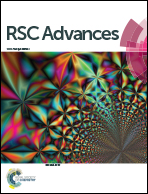Dimethyl yellow-based colorimetric chemosensors for “naked eye” detection of Cr3+ in aqueous media via test papers†
Abstract
Three colorimetric chemosensors were designed and synthesized by incorporating dimethyl yellow dye and multidentate chelating moieties into the preorganized dipodal receptors. The novel sensors display high selectivity for Cr3+ over a wide range of tested metal ions in a rapid visual output manner. UV-vis titrations with Cr3+ revealed the appearance of a new intense absorption band centered at about 515–530 nm which was accompanied by a dramatic change in color from light yellow to magenta, with the association constant being about 2.0 to 3.0 × 105 M−1. Further binding model studies by mass spectroscopy, Job’s plot, and linear fitting of the UV-vis titration curve demonstrated that the receptors formed 4 : 4, 1 : 2, and 4 : 4 binding modes with Cr3+, respectively. The easy-to-prepare test papers indicated the potential application for detecting Cr3+ in natural aqueous environments without any spectroscopic instrumentation.


 Please wait while we load your content...
Please wait while we load your content...